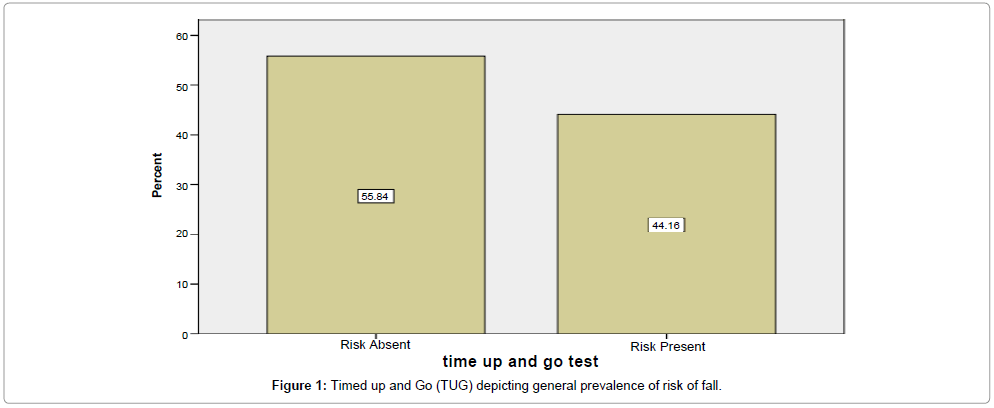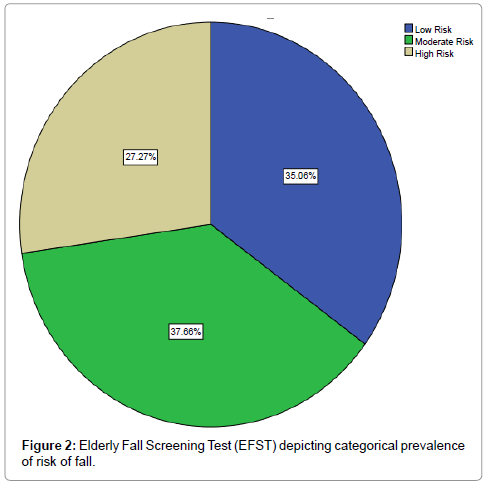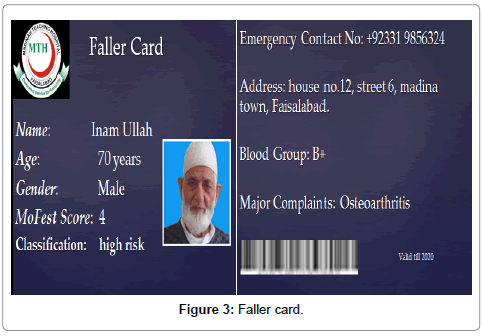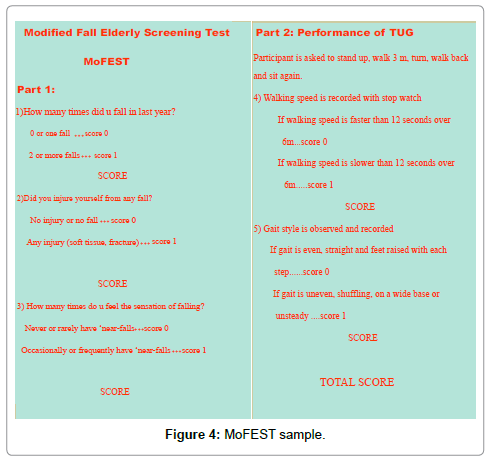Research Article Open Access
Prevalence of Risk of Fall in Community Dwelling Pakistani Male Population over the Age of 65 years
Mariam Mehmood*, Muntaha Mushtaq, Nimra Ansa and Arooj JilaniOrthopedic and Manual Physical Therapy, School of Rehabilitation Sciences, The University of Faisalabad, Faisalabad, Pakistan
- *Corresponding Author:
- Mariam Mehmood
MS Orthopedic and Manual Physical Therapy
Doctor of Physical Therapy, School of Rehabilitation Sciences
The University of Faisalabad, Faisalabad
Pakistan
Tel: 041-8868326-9
E-mail: j04group@gmail.com
Received date: August 29, 2016; Accepted date: October 15, 2016; Published date: October 25, 2016
Citation: Mehmood M, Mushtaq M, Ansa N, Jilani A (2016) Prevalence of Risk of Fall in Community Dwelling Pakistani Male Population over the Age of 65 years. J Nov Physiother 6: 309. doi: 10.4172/2165-7025.1000309
Copyright: © 2016 Mehmood M, et al. This is an open-access article distributed under the terms of the Creative Commons Attribution License, which permits unrestricted use, distribution, and reproduction in any medium, provided the original author and source are credited.
Visit for more related articles at Journal of Novel Physiotherapies
Abstract
Introduction: Falls are very common in elderly population aged above than 65 years due to the physiological changes in the body, which can reduce the health related quality of life and may lead to morbidity and mortality. Aim and objectives of study: 1) To prove that increasing age solely can be a risk factor for individuals in the absence of any major ailment. 2) To measure the overall prevalence of risk of fall in general population to know how big the problem is 3) To categorize the fallers in 3 groups low, medium and high riskier group thus to give specific high risk prevalence rate along with identification of those who specifically have high risk so that they can intervene accordingly in future. Procedure: 77 subjects meeting inclusion criteria were taken. Timed up and go test was used at first to identify subjects who were in general having risk. Then to find out association between incrementing age and increased prevalence of risk of fall, these subjects were then grouped in to three; young old (<70 years), old or middle old group (70-79 years) and very old group (>80 years). Elderly fall screening test (EFST) questionnaire was then implemented for risk categorization. Part A of the questionnaire was used which comprised a total of 5 closed ended questions giving a score for each component. Subjects were categorized on the basis of scoring; those between 0-1 as low risk, between 2-3 as medium risk and 4-5 as high risk. Results: Overall, there is a prevalence rate of 44.16% of fall in community dwelling older adults over the age of 65 as measured by TUG. While the high risk prevalence rate which was determined by EFST was 12.04% (27.27/100 × 44.16). Conclusion: Aging solely can be a major risk factor for fall in community dwelling healthy and independent older adults having no major illness. It was confirmed that with incrementing age, most subjects of the very old group tend to lie in high risk category (12/22 subjects). Contrary to that, only few subjects of the young old group lied in the high risk category. They tend to lie mostly (17/25 subjects) in the low risk category.
Keywords
Geriatrics; Old age; Old adults; Community dwelling; Prevalence; Risk of fall; Timed up and go test; Tug; Elderly fall screening test
Introduction
Fall can be defined as “a move from a higher to a lower level, typically rapidly and without control”. WHO defines fall as a person coming to rest inadvertently on to the ground or floor level or other lower level. Factors influencing stability are sensory factors, motor factors, biomechanical factors, size of base of support, height of COG above base of support mass [1].
Injury post fall is highly related with a low QOL (quality of life) and can produce decreased outcomes in terms of mobility and independence of affected person. Effects last for an extended time. Long duration drawbacks include decline in physical functioning, suspicion of falling, and institutionalization [2].
Most of the fractures among elderly population are induced by accidental fall. Most frequent fractures sites are of the backbone, pelvis, hips, legs, ankles, upper arms, forearms, and hands [3,4].
Also, the higher load of falls on healthcare system including visits in EDs (emergency departments), inpatient hospitalizations, and longterm caring can pose serious financial, psychological and functional threats to the person itself and health care providers [3].
Therefore, this research is being done in order to evaluate the fall risk in adult males to know the extent of the problem in the given region (Pakistan) by simple and reliable measures with the intention to prevent all these possible complications.
Aims and Objectives
• To find out the association between increasing age and risk of fall and thus to prove that increasing age solely can be a risk factor for individuals in the absence of any major ailment
• Determination of general overall risk along with specific high risk prevalence rate of risk of fall among community dweller elderly adult males of Pakistan.
Material and Methods
Data collection tools
In order to verify, 1 self-reported instrument (part A of EFST) and 2 performance-based measures (part B of EFST and TUG). Stopwatch, colored chalk and measuring tape were used.
Main study parameter
Age
Study type
Survey
Sample size
The sample size was 77 taken after the detailed discussion with statistician based on the number of population in the particular area where the study was held.
Sampling population
Males over the age of 65 mainly due to make the study and results uniform for a particular gender, as the rate of deterioration of general health varies greatly among male and female gender.
Sampling Technique
Convenient sampling
Setting
The data was collected from outdoor patient department of two teaching hospitals.
• Madinah teaching hospital, Faisalabad
• Allied hospital, Faisalabad
Study was approved by School of Physical therapy, The University of Faisalabad.
Selection and description of participants
Community dwelling old adults were approached, they were given a participant information sheet. Afterwards their age was confirmed by their national identity card, they were then scrutinized for their general health status by conducting a short formal verbal interview about their past medical history, present medical conditions, and one’s own information about fall history and use of medications. Then they were given a consent form to fill up by themselves in order to confirm their voluntary willingness in the research.
Inclusion criteria
Sixty five years or older that living individualistically in the society can walk without an assistive device (e.g. cane, crutch, walker, wheel chair) and without the help of someone else. They are able to ensure plain directions, capable to endure stand or walk for 6 minutes with no chest pain, shortness of breath or serious joint ache and pain in back, neck, or legs that can restrict movements.
In addition, standard for the elder people in the fall group constituted lack of common neurological or musculoskeletal disorders that could possibly cause asymmetry and slips, such as cerebro-vascular accident, cardiac problems, Parkinson’s disease, transient ischemic attacks, or joint replacements in lower limbs.
Exclusion criteria
People were excluded who had previously only one fall within past six months, for the sake of expanding the opportunity of choosing a specimen of elder people having repeated falls, deficit in cognition in terms of aphasia, severe visual and audible deterioration that might inhibit the member from performing the physical tests or answering of questionnaire. Any acute illness or exacerbation of a chronic illness would also result in exclusion.
Faller assessment procedure
The data was taken from 77 community-dwelling elder people who were the inhabitants of Faisalabad (PAKISTAN), they were enlisted in the research after taking approval from themselves in the form of a consent form which was filled up by participants and they gave their approval by their signature or thumb prints. They were given the complete instructions and information regarding tests. After that TUG and EFST both were done by subjects and the results were recorded. Brief description for the tests is being given in Tables 1 and 2.
| Timed up and go (TUG) The subjects were observed for their time, which they took in raising from chair, walked for an area of 3 meter (marked by a chalk), turned, walked back and then sit down again. Time was recorded with the help of stop watch. |
| Task done within 12 seconds=No risk Task took more than 12 seconds to complete=Risk present |
Table 1: Timed up and Go test.
| Part 1: Self-reported fall history by subject |
| 1) After defining a fall. Ask |
| 'How many times in the past year did you fall?' |
| 0-1 falls; score=0 |
| 2 or more falls; score=1 |
| 2) For those who report any fall in the past year. Ask |
| 'Did you injure yourself'?' |
| no injury from fall; score=0 |
| any injury (soft tissue. fracture); score=1 |
| 3) For all respondents. Ask |
| 'How often does it happen to you that you think you are about to fall, but manage to grab something and then don't fall?' |
| never or rarely report 'near falls'; score=0 |
| frequently or occasionally report 'near falls'; score=1 |
| Part 2: Observations and gait patterns |
| 4) Respondent is asked to walk at normal pacing speed over a 5m distance in 10 seconds |
| Walking speed is recorded with a stopwatch and walking distance is marked by chalk |
| if walking speed is faster than or equal to 10 seconds over 5m; score=0 |
| if walking speed is slower than 10 seconds over 5m; score=1 |
| 5)During performance of the above mentioned question |
| Gait style is observed and recorded |
| If gait is even straight and feet are raised with each step; score=0 |
| if gait is uneven, shuffling, and wide based or unsteady; score=1 |
| Total scoring out of 5: |
| 0-1 score=None to Low risk |
| 2-3 score=Medium risk (Moderate riskier) |
| 4-5 score=High risk (high riskier needs immediate attention) |
Table 2: Elderly fall screening test (EFST) description.
Test and questionnaire used
TUG: The first test being used was Timed up and Go (TUG) test whose reliability was high and it was proved to be sensitive and specific measure for identifying falls in community-dwelling adults [5]. Even when compared with other tests of the same type after comparison it was found that Time up and go test can give better results [6,7].
EFST: The sensitivity level of elderly fall screening test (EFST) was high (83%), meaning that the EFST accurately differentiates who are at high risk of falls from the rest means non-fallers and the specificity level was 69% [8].
Statistical analysis
Data was analyzed using SPSS version 16.0. Chi square test was applied to verify the associations between age and TUG and then age and EFST.
Results
TUG
Time up and go every subject performed test. Thirty-Four older adults covered the distance of 3 meters in greater than 12 seconds and 43 subjects covered the distance in less than 12 seconds. 44.16% older adults took time greater than the expected 12 sec and were placed in the category of those in which risk was positive. This was overall prevalence rate of fall risk in old Pakistani males over age of 65 years. The TUG test also supported the previously mentioned idea that prevalence of fall risk increases with age (Figure 1).
Age and time up and go test cross tabulation
Data analysis showed strong association between age and TUG. Results showed that risk was absent mostly in older adults in young old group of less than 70, risk was evident mostly in old and very old group. The result of descriptive analysis showed the P value less than 0.005.
EFST
To verify the hypothesis further, that incrementing age solely can be an independent fall risk factor and to clarify those different age groups of geriatric population has different prevalence of fall that undoubtedly increases with aging, another test “Elderly fall screening test” was done. In this test, three grades of risk were formulated (Subjects scoring 0-1 as low, those scoring 2-3 as moderate, and those scoring 4-5 as having high risk). 27 subjects lie in category of low risk, 29 subjects in category of moderate risk and 21 subjects in category of high risk.
Thus, specific risk prevalence turned out to be:
Low Riskier: 35.06% (approximately 35.1% as a whole)
Medium Riskier: 37.66% (approximately 37.7% as a whole)
High Riskier: 27.27% (approximately 27.3% as a whole)
This (EFST) provided deeper insight and exact figures with proper risk categorization in to groups rather than general prevalence measured by TUG (which only gave positive and negative result) and EFST also ruled out those who needs immediate attention (high riskier) (Figure 2).
EFST and age cross tabulation
Again, the hypothesis was also supported by data analysis of EFST that showed strong association between age and high risk of fall (Tables 3 and 4).
| Time up and go test | Total | |||
|---|---|---|---|---|
| Risk Absent | Risk Present | |||
| Age | <70 | 22 | 3 | 25 |
| 70-79 | 16 | 14 | 30 | |
| 80 and Above | 5 | 17 | 22 | |
| Total | 43 | 34 | 77 | |
Table 3a: Age, time-up and go test cross tabulation.
| Value | Df | Asymp. Sig. (2-sided) | |
|---|---|---|---|
| Pearson Chi-Square | 20.345a | 2 | 0 |
| Likelihood Ratio | 22.306 | 2 | 0 |
| Linear-by-Linear Association | 20.05 | 1 | 0 |
| N of Valid Cases | 77 |
Table 3b: Chi square test TUG.
| Age | Total | ||||
|---|---|---|---|---|---|
| <70 | 70-79 | 80 and Above | |||
| EFST | Low Risk | 17 | 8 | 2 | 27 |
| Moderate Risk | 7 | 14 | 8 | 29 | |
| High Risk | 1 | 8 | 12 | 21 | |
| Total | 25 | 30 | 22 | 77 | |
Table 4a: Age and elderly fall screening test cross tabulation.
| Value | Df | Asymp. Sig. (2-sided) | |
|---|---|---|---|
| Pearson Chi-Square | 24.814 | 4 | 0 |
| Likelihood Ratio | 26.465 | 4 | 0 |
| Linear-by-Linear Association | 22.642 | 1 | 0 |
| N of Valid Cases | 77 |
Table 4b: Chi square test EFST.
In this study subjects with age< 70 or young old showed low risk of falling (17 out of 25).
Old group from 70-79 showed moderate risk of falling (14 out of 30 subjects).
Very old group 80 and above showed higher risk of falling (12 out of 22).
The result of descriptive analysis showed the P value less than 0.005
Discussion
This observational cross sectional study was held from March 2015 to June 2015 in Madinah teaching hospital and Allied hospital Faisalabad (PAKISTAN). This research was done with the aim to measure the association between risk of fall and increasing age through EFST and TUG.
Falls among geriatric population varies greatly around the globe. Different researchers have reported different prevalence rates among different populations. This is because of the living habits, volume and extent of daily activity, individual’s life style (sedentary or active), the choice to exercise, participation in social activities, body mass index, home environment and environmental potential harms, hazards etc. Apart from population characteristics, the prevalence rates also varies highly due to difference in tests and questionnaire being used, methodologies applied, different settings, researcher’s approach etc.
Researchers have reported one third of geriatric population over the age of 65 falls every year and over the age of 80, there is a significant notch and one half of the population is vulnerable in United States [9-11].
Other countries showed varied prevalence with prevalence rates as follows:
34.8% in Brazil’s South and Northeast regions [12]; approximately 34% in Chile, Santiago, and Mexico City; 28.5% in Argentina; 27% in Uruguay [13] and 32% in England [11].
The high riskier prevalence rate determined by our research was 12.04% out of 44.16% general geriatric community dwelling population at risk.
There is a high need to categorize the prevalence rates in to low, medium and high riskier as done in this research. Therefore, to identify the persons who need the immediate attention and intervention as well as to identify persons depicting low or medium level risk to prevent the future havocs as to cure the problem at early level is far better and easy than at advanced stages.
Limitations of study
This study has some limitations. This study included only males to make results more accurate and uniform for the specific gender (male). This study enrolled adults aged not less than 65. Only prevalence of risk was assessed and there is a need of comprehensive evaluation of risk factors (including extrinsic factors) associated with falls, which are yet to be determined.
Conclusion
Timed up and go revealed that 44.16% of older adults in Pakistan had risk of fall in general. Out of them, the high riskier prevalence rate was 12.04% (27.27/100*44.16). This study concluded that risk of fall increases with age. Adults less than 70 years mostly lie in the category of low riskier, less than 80 mostly in the category of moderate riskier, and above 80 mostly in the category of high riskier. EFST revealed that risk of fall although present among all age groups of old; it was highest in very old group. Thus it is proved that increasing risk is directly associated with increasing age due to various factors that has yet to be determined. Aging itself is an independent risk factor for falls in the absence of any major ailment.
Recommendations
Whilst the very old group needs prevention strategies, some recommendations are given for pre injury risk prevention.
Medical card or health care cards are issued in western countries (like United Kingdom, European countries and United States of America) named as European Health Insurance Card (or EHIC) in Europe and medical card delivered by the Health Service Executive (HSE) in United States of America. These cards are issued based on their income, impairments and disabilities. Different cards are available for different age groups ranging from under 16 medical cards to over 70 years of age medical card.
In the same way, we recommend a fallers card for old adults who are at the risk of falls to prevent the further injurious complications especially the orthopedic related one. This card will help for identification of individuals at risk so that they can be taught preventive safety measures and they can then be dealt more cautiously by the health care provider. Also it is suggested here that if old adults with no or low income, they should be enrolled in free balancing programs with proper provision of free medications and other balance promoting devices like crutches, walker and canes etc. The primary goal should be to expand this program on a higher level. Faller card should enable a person to have preference in terms of using lifts and capsules, public transport, hospital seating area and on airports (even conveyers can be used to transport a person from one place to another in airport premises to avoid fall on the slippery floors).
On a national level, this card if implemented properly would result in reducing the expenses on old adults by the government. Major benefits can be attained; declining insurance claims and reducing health allowances, thus stabilizing the economy. Also, if outdoor faller patients are assessed initially and proper measures are taken then the possibility of the outdoor patients turning in to indoor ones (due to consequences of fall) will be reduced and thus in turn will result in reducing the burden on health care system. Thus, a low-priced card will benefit on individual and higher levels.
A second suggestion is also given here. Question 4 of EFST is a performance-based question and is quite similar to TUG test (as both tests require the subject to cover a specific distance in a limited timeperiod), so this part of EFST can be replaced by timed up and go test. This will augment the reliability of the screening questionnaire EFST and will be time efficient. Performing two separate performance tests will be time taking for assessor and may prove to be hectic and tiresome for individuals. The modified EFST in which TUG would become a replaced component of performance based part of test would may be termed as “MoFEST” (modified falls elderly screening test). This could help categorizing the individual in to the best suited group of risk. Moreover, it can serve as a base line fall status and can help in periodic re-evaluation of subject and also the success of treatment given. In future MoFEST should be checked for the sensitivity and specificity. Further research should be done on the reliability and validity of this modified questionnaire. In addition, comparative studies should be done, comparing the MoFEST with TUG and EFST. Samples of faller card and MoFEST are shown in Figures 3 and 4.
Acknowledgement
We would like to express our appreciation from the core of our hearts to our research supervisor, Dr. Sumaiyah Obaid (Assistant Professor; Department of Physical Therapy, The University of Faisalabad) who had truly guided us at each step of our research work in every way possible.
References
- http://www.who.int/mediacentre/factsheets/fs344/en/
- Lemaire ED, Highsmith MJ, Kaphingst W( 2009) Prosthetic and orthotic resources for communicating in a global village. JRRD 46: 13-20.
- Rubenstein LZ (2015) Falls in elderly. Merck & Co., Inc., Kenilworth, NJ, USA.
- Stevens JA, Corso PS, Finkelstein EA, Miller TR (2006) The costs of fatal and non-fatal falls among older adults. Injury prevention 12: 290-295.
- Shumway-Cook A, Brauer S, Woollacott M (2000) Predicting the probability for falls in community-dwelling older adults using the Timed Up & Go Test. Phys Ther 80: 896-903.
- Erman T, Giladi N, Hausdorff JM (2011) Properties of the ‘timed up and go’test: more than meets the eye. Gerontology 57: 203-210.
- Nordin E, Lindelöf N, Rosendahl E, Jensen J, Lundin-Olsson L (2008) Prognostic validity of the Timed Up-and-Go test, a modified Get-Up-and-Go test, staff's global judgement and fall history in evaluating fall risk in residential care facilities. Ageageing 37: 442-448.
- Cwikelt JG, Fried AV, Biderman A, Galinsky D (1998) Disability and Rehabilitation. Disabil Rehabil 20: 161-167.
- Blake AJ, Morgan K, Bendall MJ, Dallosso H, Ebrahim SB, et al. (1988)Falls by elderly people at home: prevalence and associated factors. Age ageing 17: 365-372.
- O'Loughlin JL, Robitaille Y, Boivin JF, Suissa S (1993) Incidence of and risk factors for falls and injurious falls among the community-dwelling elderly. Am J Epidemiol 137: 342-354.
- Tinetti ME, Speechley M, Ginter SP (1988) Risk factors for falls among elderly persons living in the community. N Eng J Med 319: 1701-1707.
- SiqueiraFV, Facchini LA, Piccini LX, Tomasi E, Thumé E, et al. (2007) Prevalência de quedas emidosos e fatoresassociados. RevSaúde Pública 41:749-756.
- Reyes-Ortiz CA, Al Snih S, Markides KS (2005) Falls among elderly persons in Latin America and the Caribbean and among elderly Mexican-Americans. Rev Panam Salud Pública 17:362-369.
Relevant Topics
- Electrical stimulation
- High Intensity Exercise
- Muscle Movements
- Musculoskeletal Physical Therapy
- Musculoskeletal Physiotherapy
- Neurophysiotherapy
- Neuroplasticity
- Neuropsychiatric drugs
- Physical Activity
- Physical Fitness
- Physical Medicine
- Physical Therapy
- Precision Rehabilitation
- Scapular Mobilization
- Sleep Disorders
- Sports and Physical Activity
- Sports Physical Therapy
Recommended Journals
Article Tools
Article Usage
- Total views: 11968
- [From(publication date):
October-2016 - Aug 18, 2025] - Breakdown by view type
- HTML page views : 11000
- PDF downloads : 968




